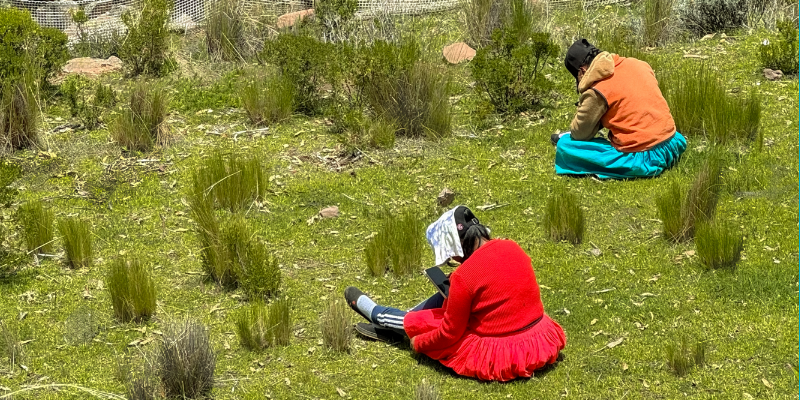Making sense of our connected world

Exploring digitalisation: Indigenous perspectives from Puno, Peru
Indigenous communities offer valuable insights on alternatives to our typical global economy and how to build sustainable digital businesses. In this blog post, Paul Vilchez reflects on his observations during a recent visit to Quechua communities in Puno. Here, digital technologies emerge as a tool of empowerment and economic independence. What can we learn from the intersection of ancestral wisdom and innovation to reshape our approach to build digital companies?
Within management and organisation studies, Indigenous literature has been gaining attention as an alternative to the Western principles that are largely responsible for the environmental and social problems the world faces today. At the same time, while digitalisation can be used to do good, major digital platforms have been criticised for being based on commercial values. Therefore, diverse Indigenous perspectives on digitalisation can offer valuable insights into how we can steer digital projects sustainably. In this article, I share reflections on a recent visit to Quechua communities in Puno, Peru. Puno is a region in the south of Peru where 90.8% of the population self-identifies as Indigenous. Moreover, 42% of the population’s mother tongue is Quechua, which was also the official language of the Incas. Throughout the years, the Quechuas – along with other Indigenous groups in the region – have kept their traditions and fought to remain autochthonous and protect their lands. Speaking with local entrepreneurs and people from urban and rural areas, I learned about the emancipatory value of digital technologies, the challenges of growing the digital sector and how their ancestral principles and traditions frame new developments in the region.
The emancipatory value of digital technologies
Quechua communities in Puno have largely maintained agriculture as their main economic activity. However, in recent decades, they have also engaged with ethnic tourism and artisanal production as additional and impactful endeavours. Digital technologies have helped Quechuas gain independence from outside players in these industries, who dictate prices and schedules. For example, tourism in Puno has been lower than in other parts of Peru, and travel agencies have favoured certain towns more than others. Digital lodging platforms are playing an important role in the autonomous development of tourism in the area because they allow Quechuas to directly connect with guests. For instance, Taquile Island in Lake Titicaca is often sold to tourists as a half-day boat tour starting in the city of Puno; this is changing as more residents of Taquile are building lodges and persuading tourists to stay longer in the area. Another example of the emancipatory value of digital technologies is the use of social media, as it enabled artisans to continue selling their products through the devastating economic turmoil of the COVID-19 pandemic. The use of digital technologies within Quechua communities has been growing and is playing an important role in local economies. Still, they currently use mostly enabling digital technologies, such as social media and apps. The question is: how large is the potential for growing the digital economy in this region?
Onwards to a larger digital economy
It is important to remember that Indigenous communities often have a history of suppression. Quechuas in Peru suffered from systems of mandated servitude (called pongaje) and were subject to especially high taxes, among other injustices. Consequently, many communities today live in extreme poverty. While the region has rather modern urban areas like Juliaca and the city of Puno (I even found a gym with a face-recognition system), rural communities have more limited access to digital technologies. For instance, internet coverage varies dramatically across settlements (in the islands of Amantani and Taquile, there is only one reliable internet provider). At the same time, conversations with educational professionals revealed that most schools (and municipal libraries) do not have computer labs, meaning there is an urgent need for training in basic computing skills for teachers and students. As described in these first sections, while there are many interesting examples of digital technology adoption in the region of Puno, there is also a large gap in the region in being able to provide digital access and training to its people.
Framing developments within ancestral principles
Despite some initial small initiatives, there are few examples of larger digital projects in this region. However, as the region engages more with digital technologies, it is important to consider the Quechuas’ way of life with a view to imagining an authentic digital economy. The Quechuas’ way of life is rooted in honouring and depending on nature and their communities. One of the many ancestral rituals and principles is the tribute to Pachamama and the ayni. In the tribute to Pachamama, people bring their best crops and other gifts as offerings to Mother Earth. While there is an official celebration in August, it more often takes place privately. Ayni is the principle of “today for you, tomorrow for me”, which is reflected in a spirit of reciprocity and cooperation regarding work. This principle is often associated with the building of houses, where members of a community come for full days to build another community member’s house. Simple construction projects can take up to two days. The future house owner is also expected to participate in building houses for other people from the community.
This strong sense of care for nature and their communities is also evident among entrepreneurs. One case that stood out for me during my recent visit was that of solidarity tourism, a concept introduced to me by the owner of a well-known lodge. He has intentionally decided to limit his business to lodging, because, among other reasons, he believes his whole community should benefit from tourism and not just his family. He continues to support other members of his community in related and even competing ventures (related to food, transportation, etc). The tribute to Pachamama and the ayni are just a few examples of the rich and lively worldview of the Quechua communities in Peru.
Embracing indigenous perspectives of digitalisation (Closing thoughts)
There is increasing interest in including the voices of Indigenous people in the development of digital projects; however, barriers to equitable inclusion are still very prevalent in different parts of the globe. The Quechuas of Puno are still at an early stage of their participation in the digital economy. Continuing to support their inclusion through digital learning and accessibility may expedite this process as well as helping protect the identity of these communities. It is important to continue questioning the frameworks through which digital projects are implemented and support projects that offer alternatives to our typical global economy. The region of Puno has room to grow within the digital economy, but the principles, way of life and the way they are translated into entrepreneurial ventures can inspire local and global people alike to build sustainable digital companies.
References
Dijck, J. van. (2020). Governing digital societies: Private platforms, public values. Computer Law & Security Review, 36, 105377. https://doi.org/10.1016/j.clsr.2019.105377
Gregori, P., & Holzmann, P. (2020). Digital sustainable entrepreneurship: A business model perspective on embedding digital technologies for social and environmental value creation. Journal of Cleaner Production, 272, 122817. https://doi.org/10.1016/j.jclepro.2020.122817
Salmon, E., Chavez R., J. F., & Murphy, M. (2023). New Perspectives and Critical Insights from Indigenous Peoples’ Research: A Systematic Review of Indigenous Management and Organization Literature. Academy of Management Annals, 17(2), 439–491. https://doi.org/10.5465/annals.2021.0132
Traxler, J. (2019). Only Connect—Indigenous Digital Learning. Interaction Design and Architecture(s), 41, 7–23. https://doi.org/10.55612/s-5002-041-001
This post represents the view of the author and does not necessarily represent the view of the institute itself. For more information about the topics of these articles and associated research projects, please contact info@hiig.de.

You will receive our latest blog articles once a month in a newsletter.
Digitalisation and sustainability
The Human in the Loop in automated credit lending – Human expertise for greater fairness
How fair is automated credit lending? Where is human expertise essential?
Impactful by design: For digital entrepreneurs driven to create positive societal impact
How impact entrepreneurs can shape digital innovation to build technologies that create meaningful and lasting societal change.
Identifying bias, taking responsibility: Critical perspectives on AI and data quality in higher education
AI is changing higher education. This article explores the risks of bias and why we need a critical approach.




